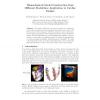Free Online Productivity Tools
i2Speak
i2Symbol
i2OCR
iTex2Img
iWeb2Print
iWeb2Shot
i2Type
iPdf2Split
iPdf2Merge
i2Bopomofo
i2Arabic
i2Style
i2Image
i2PDF
iLatex2Rtf
Sci2ools
MICCAI
2002
Springer
2002
Springer
Biomechanical Model Construction from Different Modalities: Application to Cardiac Images
This article describes a process to include in a volumetric model various anatomical and mechanical information provided by different sources. Three stages are described, namely a mesh construction, the non-rigid deformation of the tetrahedral mesh into various volumetric images, and the rasterization procedure allowing the transfer of properties from a voxel grid to a tetrahedral mesh. The method is experimented on various imaging modalities, demonstrating its feasibility. By using a biomechanical model, we include physically-based a priori knowledge which should allow to better recover the cardiac motion from images.
Medical Imaging | MICCAI 2002 | Tetrahedral Mesh | Various Imaging Modalities | Various Volumetric Images |
| Added | 15 Nov 2009 |
| Updated | 15 Nov 2009 |
| Type | Conference |
| Year | 2002 |
| Where | MICCAI |
| Authors | Maxime Sermesant, Clement Forest, Xavier Pennec, Hervé Delingette, Nicholas Ayache |
Comments (0)

